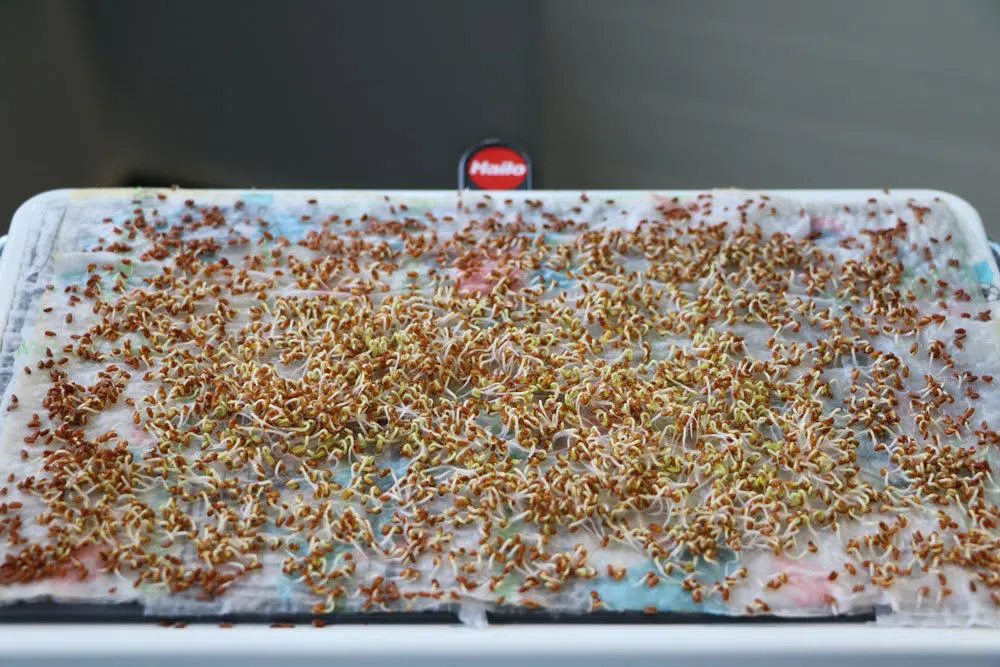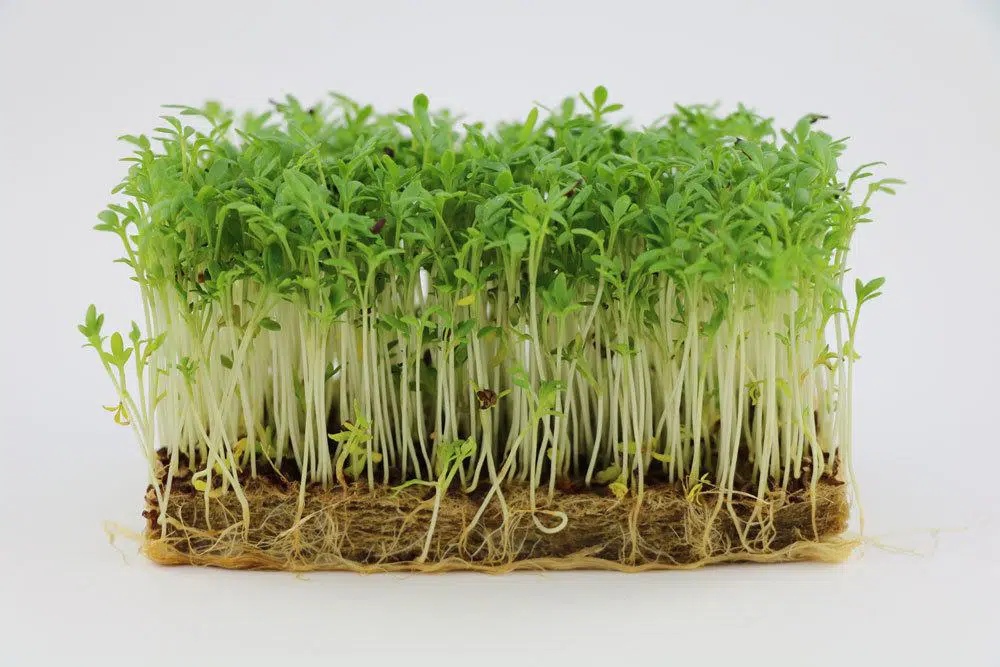Cress is considered a classic among green herbs. It is a popular and healthy seasoning herb that provides an extra dose of vitamins and minerals, especially in winter. Growing this seasoning herb is child’s play, possible at any time of year and on almost any moist surface, even on conventional absorbent cotton or kitchen roll. After just a few days, the young plantlets can be harvested and immediately consumed or give dishes that certain something.
Contents
Sowing time
In contrast to sowing in the garden or in soil, which is possible from May to September, there is no best sowing time for sowing without soil. This aromatic herb can be grown all year round on different substrates. Cress seeds are very productive and the seedlings should be used up as quickly as possible, because their shelf life is limited. In order to be able to harvest fresh plants again and again, it is advisable not to sow too many seeds at once. It is best to sow again and again at regular intervals.
Growing without soil
Hardly any other herb is as easy to grow as cress. It does not even require soil, it can be sown on almost any surface, as long as it is moist. The necessary materials are usually available in every household.
- A shallow bowl as a growing container
- Spray bottle for moistening the seed and the substrate
- As spare substrates some absorbent cotton, kitchen roll or a piece of planting fleece
- Cellulose tissues or toilet paper can also be used
- Advantages and disadvantages of these materials
All these materials have the advantage that the fine seeds can settle well in the structure of these materials. There is no danger of them rotting or suffocating from too much wetness if handled properly. The seeds draw the required amount of water from the absorbent substrates.
A disadvantage is that the fine roots grow tightly to the absorbent cotton or kitchen paper, so that the upper parts of the plant must be cut off for harvesting. Another disadvantage is that this substrate substitute dries out relatively quickly, requiring more frequent watering. For those who want to grow green weed more frequently or in larger quantities, commercially available germination aids or so-called germination devices are available. These can be germination sieves, germination jars, so-called sprout towers or the well-known cress hedgehog.
- Growing on absorbent cotton or kitchen roll
- Absorbent cotton or kitchen paper easiest method to grow fresh cress without soil.
- First, line a shallow tray with absorbent cotton or several sheets of kitchen paper
- Then moisten the whole well
- There should be no water in the bowl
- Spread the cress seeds generously on the moist growing medium
- Distribute the seeds as evenly as possible
- They should not lie on top of each other
- Close together is not a problem
- Now moisten the seeds one more time
- Ideally by means of a spray bottle and a fine spray mist
Once the seeds have been sown and the growing medium, i.e. absorbent cotton or kitchen crepe, is well moistened, the seed tray should be placed in a bright or semi-shaded area, preferably a bright window sill. Direct sun should be avoided, it would dry out the replacement substrates and thus the seeds very quickly.
Tip: If you want to grow seeds from your own little plants, you should grow some cress outdoors and let it come to flower, which is usually hardly possible on the window sill. The flowers will eventually develop into small pods containing the seeds.
Growing with commercially available germinators
In addition to common household means such as absorbent cotton or kitchen paper, so-called germinators, which are mainly used for sprout cultivation, are also suitable for growing cress. As a rule, these are made of environmentally friendly materials and offer an optimal incidence of light, which positively influences the germination process and the growth conditions of this green herb. You can choose between a cress urchin, a cress sieve and sprout towers. Commercially available sprouting jars are less suitable for growing greenweed.
Cress sieve
Cress sieve is a very effective, simple and clean way to grow the seasoning weed without any soil at all. It usually consists of a stainless steel sieve enclosed in high-quality glass or ceramic bowl. Depending on the model and manufacturer, the sieves can be of different sizes. On this sieve you can grow or germinate both the green weed and sprouts.
- Before sowing, soak the seeds in water for about a quarter of an hour.
- According to the diameter of the sieve, distribute seeds on the sieve
- 1 teaspoon for sieve diameter of 12 cm
- 2 teaspoons for 16 cm diameter
- 4 teaspoons for a diameter of 21.5 cm
- Sow seeds as evenly as possible on the cress sieve
- Water regularly until roots are formed (2-3 days).
- To do this, wet the seeds with water twice a day using a spray bottle
- Cover the tray for the first two days
- This prevents the seed from drying out
- Choose a cover according to the size of the sieve
- For example, cover with a saucer, cake plate or dinner plate

Once the seeds have germinated and the fine roots push through the sieve, both the roots and the seedlings should be rinsed once a day under running water. After 5 – 8 days, in most cases, the first fresh cress can be harvested. Once the sieve is completely harvested, it can be easily cleaned and the next seed can be started.
Cress hedgehog
The cress hedgehog is a very decorative alternative to the cress sieve. Especially children have a lot of fun with it. The cress hedgehog is a pure clay container in the shape of a hedgehog, which is also offered in different sizes. Before you start sowing, fill the container with water and let it stand for about half an hour, so that the clay is well soaked with water. Water that is then still in the hedgehog is poured off, and then the seeds are spread thinly and evenly over the surface. Again, it is necessary to moisten the seeds daily. Harvest the piquant and spicy-hot green herb after about 5 – 6 days.
Tip: Together with the fresh green, the cress hedgehog is extremely decorative and looks very good on the breakfast table, for example.
Sprout towers
Sprout towers are particularly popular as germination aids. They are usually made of plastic and have several levels. These can be shortened or extended as required. The upper level is particularly suitable for growing green weeds or cress, while the lower levels are more suitable for tall-growing sprouts such as mung beans.
The principle is similar to that of the cress sieve. The seeds are first soaked and then distributed again evenly in the appropriate level. Twice a day they should be watered. For this purpose, water is poured into the upper level, which is then removed through the lowest levels and collected in a collection tray. The water in the collection tray can then be used for watering flowers, if necessary.

Problems with growing cress
Lack of light
Cress seeds need sufficient light to germinate and grow. If it is too dark, the plantlets shoot up. In addition, depending on what tools you use for germination, they always grow towards the light, so you should occasionally change their position, turning or aligning them according to the light. In addition, when growing cress, make sure it is well ventilated.
Mistakes in watering
However, what is most important in growing such seeds is proper watering. Too little moisture will be just as deadly to the seeds as too much. Cress should be kept evenly moist but not wet at all times. Watering should only be done using a spray bottle. Too strong a stream of water could wash away all the seeds or push the tender plantlets to the ground. Stale water should also not be used.
Mildew
A common problem caused by contaminated germinators, unsuitable substrates, and especially too much wetness is mold growth. Mold spores are hazardous to health and should be avoided at all costs.
- In case of suspected or obvious mold infestation, dispose of the entire cress cultivation unit
- Then clean the germinator thoroughly
- Watering as needed can usually prevent mold growth
- Mold possibly also the result of contamination
- Therefore thoroughly clean the respective planting ground before sowing
- Ideally rinse with boiling water
Since the fine fibrous roots of the seedlings can easily be mistaken for an initial mold infestation, an odor test should be made before disposal, if necessary. A musty, unpleasant odor usually indicates an infestation; if, on the other hand, it smells fresh and spicy, the cress is in perfect condition.
Tip: If you keep the room temperature between 18 and 20 degrees as cool as possible, you can both reduce the germ load and ensure that this spicy herb stays fresh for longer.


